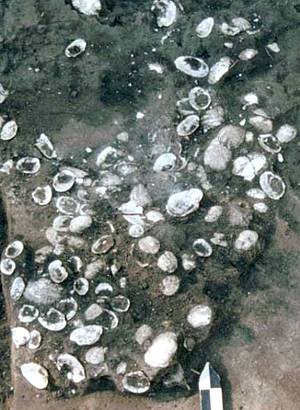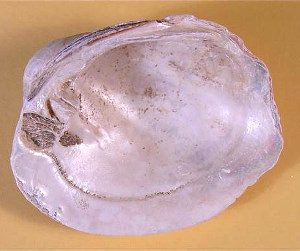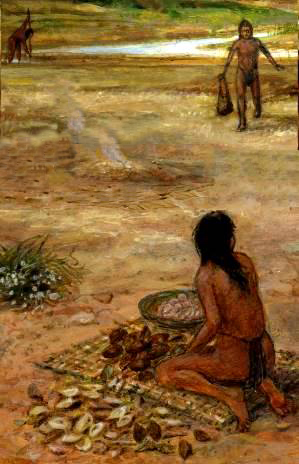|
|
Mussel Collecting
The Bosque rivers are home to various aquatic food resources, including freshwater mussels. Living in mud, sand, and gravel beds of both flowing waters or pools, these bivalved creatures can attain sizes from around 2.5 to 15 cm (1 to 6 inches or more). Archeologists discovered scatters and piles of their shells—the remains of prehistoric meals—at several campsites. Archeologists believe that mussels, which were easy to collect in large numbers, were never a major food source for Native Americans in the area, because they are nutritionally poor in terms of calories and protein.
Mussel shells were recovered from every analysis unit of the four sites investigated for this project. By far the most common species recovered at the Britton, McMillan, and Higginbotham sites is the type known as Threeridge, with Smooth Pimpleback, Louisiana Fatmucket, and Pistolgrip representing sizable minority populations. These species are adaptable to various riverine habitats and are able to tolerate low-quality waters, but they typically flourish in moderate to large streams. Their abundance at the sites suggests they were readily accessible and thrived in dense beds in the North Bosque River. Generally, the archeologically recovered shells are small in size, suggesting that prehistoric food collectors were intensely exploiting this resource. Given their prevalence at the sites through time, this intense collection apparently did not threaten local populations.
Paradoxically, although mussels were frequently and intensively collected, they are nutritionally poor. In terms of calories from protein and fat, Texas freshwater mussels ranked quite low compared to terrestrial game animals, such as deer, according to studies conducted by archeologist Christopher Lintz and others. However, they do contain high levels of certain minerals such as calcium and iron. Lintz found that, based on an average yield of 23.8 grams (.08 ounces) of meat per mussel from a sample of modern mussels, it would take almost 1,900 mussels to yield 45.5 kilograms (100.31 pounds) of meat or flesh. From the same modern sample, he calculated that it would take approximately 3,300 mussels to equal the amount of calories and protein that 45.5 kg of venison would yield.
Given that the mussels consumed at the Baylor, Britton, McMillan, and Higginbotham sites are smaller than those modern samples collected and analyzed by Lintz, the amounts of 1,900 and 3,300 mussels are underestimates. An examination of a sample of Pistolgrip shells from the Britton and Higginbotham sites revealed that they are 50 to 39 percent smaller than Lintz’s modern Pistolgrip sample. It would therefore take between 5,428 and 6,600 mussels to yield the equivalent of 45.5 kg of deer meat in calories and protein. Given that, to satisfy a 2,000-calorie daily diet an individual would have to consume approximately 180 to 220 mussels. Clearly, despite the large number of shells, mussels were never a major part of the diet in caloric terms. Given their poor nutritional value, one has to wonder: Why were mussels exploited at all?
Diet breadth models (see Research Approaches) suggest that high cost/low return food items will get added to the diet when high-ranked resources become scarce or costly. Seemingly, however, high-ranked resources such as deer were, at least over extended periods of time, never scarce in the vicinity of the Waco Lake sites, nor were other foods such as geophytes. It is then reasonable to assume that mussels, although nutritionally poor (i.e., low return), must have been readily available at relatively low costs. In other words, mussels probably occurred in dense beds in shallow waters where their poor nutritional value could be offset through the collection of large numbers of them with little effort.
Based on the large numbers of shells found in disposal areas and refuse dumps at the Britton and McMillan sites, it appears that mussels were consumed throughout the duration of site occupations, and not because high-ranked resource returns dwindled. These dense shell clusters as well as shell dumps associated with hearths are assumed to represent discrete disposal episodes or, said differently, the remains of family meals.
Clearly, if these shell features represent the food of a family unit, even a small family’s daily caloric needs would not have been met since none of these features contain more than 371 shells (186 mussels provide ca. 2.2 to 2.7 kg [roughly 5-6 pounds] of meat yielding ca. 1,693 to 2,065 calories). What this suggests is that relatively small numbers of mussels were collected and consumed daily by families to augment their diets. The overall number of shells recovered, and their small size, suggest that this activity occurred repeatedly throughout the duration of the occupations at these sites.

|

|

